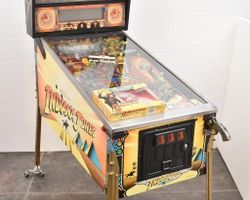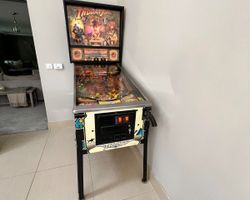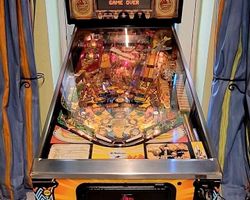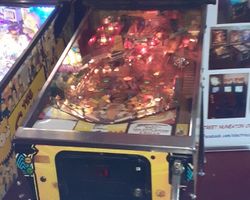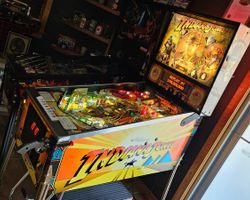Indiana Jones: The Pinball Adventure
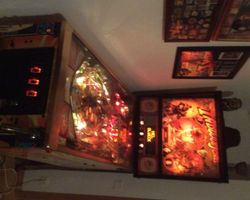
Average Prices: USD $1,600 to $5,400
Produced: August, 1993
Production Run: 12,716 units
Machine Type: Solid State Electronic
MPU: Williams WPC (DCS)
Players: 4
Concept by: Doug Watson, Mark Ritchie, Brian Eddy
Design by: Doug Watson, Mark Ritchie
Art by: Doug Watson
Dots/Animation by: Scott Slomiany, Eugene Geer
Mechanics by: Jack Skalon
Music by: Chris Granner
Sound by: Rich Karstens
Software by: Brian Eddy
Released in August 1993 by Williams, Indiana Jones: The Pinball Adventure emerged as a widebody spectacle, captivating players with its cinematic theme and innovative features. This machine, was a product of Williams' "SuperPin" line, designed to offer a more expansive and feature-rich pinball experience. The game's thematic inspiration is clearly drawn from the Indiana Jones film franchise, immersing players in a world of adventure and archaeological pursuits.
Indiana Jones: The Pinball Adventure reached production on August 1st, 1993, and achieved a confirmed production run of 12,716 units. A notable milestone is its distinction as the first pinball machine to utilize Williams' Digital Compression System (DCS) for sound. Interestingly, Twilight Zone was initially slated to debut this sound system. Adding to the game's auditory richness, custom speech was incorporated, featuring the voice of John Rhys-Davies, known for his portrayal of Sallah in the Indiana Jones films.
Early production models of Indiana Jones: The Pinball Adventure exhibit subtle differences compared to the standard production run. These variations include steel side rails on the mini-playfield instead of red plastic, a black-and-white background for the Super Jackpot insert instead of an all-black design, and provision for three Jackpot lamps on the speaker panel, a feature not implemented in later production models despite remaining in the software. Furthermore, early versions included a large decorative plastic piece along the back wall of the playfield, which was later omitted from production. Enthusiasts have occasionally sought to reinstate this "lost plastic" in their machines.
Signature Features and Design
Indiana Jones: The Pinball Adventure is defined by several standout features that contribute to its unique identity. Visually, the rotating golden idol head dominates the playfield, acting as a central toy that dramatically releases balls into play, setting the adventurous tone from the outset. Another prominent toy is the pair of airplanes, recreating the iconic dogfight scene from "Raiders of the Lost Ark," adding a dynamic visual element.
Mechanically, the machine incorporates a distinctive player-controlled tilting mini-playfield, referred to as the "Path of Adventure." This long, narrow upper playfield challenges players to steer the ball using the flipper buttons, demanding skillful nudging and flipper control. The inclusion of a captive ball shot adds another layer of engaging interaction, requiring precision to activate targets and modes.
The game is designed for up to four players and is a widebody cabinet, offering a more expansive playfield and a grander physical presence. It features two flippers and employs a dot matrix display to present scores, animations, and game information. The game boasts an automatic plunger, streamlining ball launches. Aesthetically, the artwork, credited to Doug Watson, captures the adventurous spirit of the Indiana Jones series, enhancing the thematic immersion through visual storytelling.
Playfield and Mechanics
The playfield of Indiana Jones: The Pinball Adventure is a multi-leveled landscape packed with features and interactive elements. It incorporates two ramps, three pop bumpers, and two slingshots, the standard fare of a dynamic pinball layout. Seven standup targets and two kick-out holes add further shot variety. A 3-bank drop target set and a captive ball are strategically placed to challenge players and trigger specific game events.
The layout is designed to facilitate a sense of flow and adventure, guiding the ball through various paths and challenges that mirror the film narratives. The "Path of Adventure" mini-playfield, positioned at the top of the playfield, acts as a distinct sub-game, requiring players to master tilting for successful navigation. The overall design philosophy emphasizes player immersion, attempting to replicate the excitement and peril of an Indiana Jones expedition through its mechanical and visual design.
The playfield artwork is integral to the game's aesthetic. It is rich in detail and thematically consistent, depicting scenes and characters from the movies. The lighting scheme is designed to highlight key playfield areas and features, contributing to the visual dynamism and guiding player attention. The dot matrix display animations complement the playfield action, providing visual feedback and narrative context to the gameplay.
Gameplay Dynamics
Indiana Jones: The Pinball Adventure distinguishes itself through its varied gameplay mechanics, progression system, and scoring opportunities. The game is designed around a mission-based structure, prompting players to embark on different "adventures" inspired by the film series. These missions are initiated by hitting specific targets and shots, unlocking diverse gameplay scenarios.
A key element is the inclusion of four multiball modes, each offering a unique objective and scoring potential. The standard 3-ball multiball is complemented by "Quick Multiball," a faster-paced 2-ball mode. "Well of Souls" multiball unleashes a chaotic 6-ball frenzy, while "Eternal Life" wizard mode, also a 6-ball multiball, represents the pinnacle of gameplay, achievable by completing numerous objectives.
Three video modes offer a break from traditional pinball play. "Gunfight at the Raven Bar" challenges players to a shooting gallery sequence. "Escape in the Mine Cart" is a side-scrolling avoidance game. "Choose Wisely" is a shell game based on the Grail scene from "Indiana Jones and the Last Crusade".
The scoring system is layered, rewarding players for completing missions, achieving multiballs, and executing skillful shots. Strategies often revolve around efficiently starting and completing modes to maximize scoring. The game's challenges and mode variety contribute to its replayability, offering numerous paths to explore and high scores to chase. One of the jackpot awards during Quick Multiball, "The Fish of Tayles," is a playful reference to Mark Ritchie's previous design, Fish Tales.
Reception and Legacy
Indiana Jones: The Pinball Adventure generally receives positive feedback from the pinball community, although opinions are nuanced. Strengths frequently cited include its strong thematic integration, successfully capturing the essence of the Indiana Jones movies through sound, visuals, and gameplay. Players appreciate the variety of missions, video modes, and multiball features, which contribute to engaging and diverse gameplay experiences. The unique mechanics, such as the mini-playfield and captive ball, are often praised for their creativity and interactivity. Many express nostalgic affection for the game, often connected to childhood memories or fandom of the movie series. The replay value is considered high due to the numerous modes and scoring strategies available.
However, criticisms are also voiced. Some players find the playfield layout to be somewhat cluttered, which can impact gameplay flow and make certain shots feel tight or difficult. The mode start hole is sometimes described as finicky, with shots intended to initiate modes occasionally ejecting unexpectedly. The ramps are noted for their steepness, leading to potential drains if shots are not precisely executed. While the thematic artwork is generally appreciated, some find elements of the cabinet art less refined or dated. The overall gameplay experience is also recognized as being sensitive to machine maintenance and setup, with poorly maintained machines potentially leading to frustrating gameplay.
Despite these criticisms, Indiana Jones: The Pinball Adventure holds a strong legacy in pinball history. Its production numbers, exceeding 12,000 units, indicate its commercial success and widespread appeal. It is often regarded as a classic machine, influencing subsequent pinball designs, particularly in the use of widebody cabinets and the integration of complex sound systems like DCS. For many collectors and enthusiasts, Indiana Jones: The Pinball Adventure remains a sought-after title, representing a high point in 1990s pinball design and a testament to the enduring appeal of the Indiana Jones franchise.
 Active Auctions
Active Auctions
 Auction Results
Auction Results
| Cost | Location | Date |
|---|---|---|
| GBP £7,500 |  United Kingdom United Kingdom |
15 October, 2024 |
| EUR €31,500 |  Baden-Württemberg, Germany Baden-Württemberg, Germany |
27 August, 2024 |
| USD $13,380 |  Pennsylvania, United States Pennsylvania, United States |
03 August, 2024 |
| USD $12,999 |  Florida, United States Florida, United States |
22 July, 2024 |
| GBP £7,000 |  Farnham, United Kingdom Farnham, United Kingdom |
05 July, 2024 |
| USD $10,500 |  Nevada, United States Nevada, United States |
26 April, 2024 |
| USD $10,800 |  Ohio, United States Ohio, United States |
29 March, 2024 |
| USD $16,300 |  Iowa, United States Iowa, United States |
21 January, 2024 |
| AUD $15,100 |  New South Wales, Australia New South Wales, Australia |
31 December, 2023 |
| USD $14,500 |  Connecticut, United States Connecticut, United States |
30 November, 2023 |


Private Policy · Search Website · Contact Us
All trademarks and copyrighted materials remain property of their respective owners.
All other content copyright 2007 - 2025 Pinpedia.

